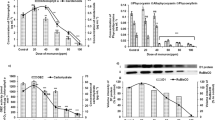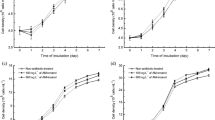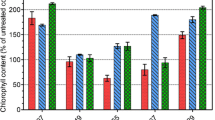Abstract
Application of monosulfuron, a new sulfonylurea herbicide, produced a simulative effect on heterocyst formation and nitrogenase activity but an inhibitory effect on photosynthesis, i.e., a lower net photosynthetic rate, fewer photosynthetic pigments, and a smaller Fv/Fm ratio at increasingly higher monosulfuron concentrations (0.001–10 mg/l) for three nonspecific filamentous nitrogen-fixing cyanobacteria: Anabaena azollae, A. flos-aquae, and A. azotica. The decrease in biliprotein of algal cells was less than that of carotenoid and chlorophyll-a. Monosulfuron was more readily degraded and less accumulated in A. azotica compared with A. azollae and A. flos-aquae. The three algae exhibited varying degrees of sensitivity to monosulfuron: Calculated 50% inhibition concentrations (IC50s) of algal growth and no observed-effect concentration (NOEC) values after 4 days of treatment were 0.014 and 0.005, 0.029 and 0.019, and 0.22 and 0.075 mg/l for A. flos-aquae, A. azollae, and A. azotica, respectively. Normal agricultural use of monosulfuron at postemergence rates of 0.3–0.8 mg/l in rice fields will likely be toxic to these three ubiquitous nitrogen-fixing cyanobacteria. Low-dose monosulfuron application (<0.1 mg/l) enables growth of the more tolerant A. azotica as biofertilizer, and the use of photosynthetic efficiency and growth rates as sensitive-indicator indexes of toxicity to nitrogen-fixing cyanobacteria are recommended.







Similar content being viewed by others
References
Adams JB, Bate GC (1999) Growth and photosynthetic performance of Phragmites australis in estuarine waters: a field and experimental evaluation. Aquat Bot 64:359–367
Bester K, Huhnerfuss H, Brockmann U, Rick HJ (1995) Biological effects of triazine herbicide contamination on marine phytoplankton. Arch Environ Contam Toxicol 29:277–283
Burris RM (1975) The acetylene-reduction technique. In: Stewart WDP (ed) Nitrogen fixation by free-living micro-organism. Cambridge University Press, London, England, pp 249–257
Chen WC, Yen JH, Chang CS, Wang YS (2008) Effects of herbicide butachlor on soil microorganisms and on nitrogen-fixing abilities in paddy soil. Ecotoxicol Environ Saf 25:1–7
Das AC, Debnath A (2006) Effect of systemic herbicides on N2-fixing and phosphate solubilizing microorganisms in relation to availability of nitrogen and phosphorus in paddy soils of west Bengal. Chemoshpere 65:1082–1086
Ernst A, Böhme H, Böger P (1983) Phosphorylation and nitrogenase activity in isolated heterocysts from Anabaena variabilis. Biochim Biophys Acta 723:83–90
Fay P, Van Baalen C (1987) The cyanobacteria. Elsevier, New York, NY, p 543
Fernández-Valiente E, Ucha A, Quesada A, Leganés F, Carreres R (2000) Contribution of N2 fixing cyanobacteria to rice production: availability of nitrogen from 15N-labelled cyanobacteria and ammonia sulphate to rice. Plant Soil 221:107–112
Glazer AN, Hixson CS (1975) Characterization of R-phycocyanin chromophore content of R-phycocyanin and C-phycoerythrin. J Biol Chem 250:5487–5495
Habte M, Alexander M (1980) Nitrogen fixation by photosynthetic bacteria in lowland rice culture. Appl Environ Microbiol 39:342–347
Irisarri P, Gonnet S, Monza J (2001) Cyanobacteria in Uruguayan rice fields: diversity, nitrogen fixing ability and tolerance to herbicides and combined nitrogen. J Biotechnol 91:95–103
Jenssen A (1978) Chlorophyll and carotenoids. In: Hellebust JA, Craigie JS (eds) Handbook of phycological methods: physiological and biochemical methods. Cambridge University Press, Cambridge, UK, pp 59–70
Jian YM (1981) The secret of biological nitrogen fixation. Sciences Press, Beijing, China, pp 212–330
Jin XC, Chu QY (1990) The rule of eutrophication investigation in lake. Environmental Sciences Press, Beijing, China, pp 30–150
Li ZM, Jia GF, Wang LX (1994) Sulfonylurea compounds and its herbicide usage. Chinese patent no. CNI 080 116A
Mackinney G (1941) Absorption of light by chlorophyll solutions. J Biol Chem 140:315–322
Mattoo HK (1984) Adaptive reorganization of protein and lipid components in chloroplast members as associated with herbicide binding. J Cell Biochem 24:145–163
Miquel LL, Ivo R (2006) On the way to cyanobacteria blooms: Impact of the herbicide metribuzin on the competition between a green alga (Scenedesmus) and a cyanobacterium (Microcystis). Chemosphere 65:618–626
Mishra AK, Pandey AB, Kumsr HD (1989) Effects of three pesticides on MSX-induced ammonia photopronuction by the cyanobacterium Nostoc linkia. Ecotoxicol Environ Saf 18:145–148
Padhy RN (1985) Cyanobacteria and pesticides. Residue Rev 95:1–4
Patnaik GK, Kanungo PK, Moorthy BTS, Mahana PK, Adhya TK, Rajaramamohan RV (1995) Effect of herbicides on nitrogen fixation (C2H2 reduction) associated with rice rhizosphere. Chemosphere 30:339–343
Prithiviraj B, Perry LG, Badri DV, Vivanco JM (2007) Chemical facilitation and induced pathogen resistance mediated by a root-secreted phytotoxin. New Phytol 173:852–860
Shen JY, Lu YT, Cheng GH (2005) Effects of chemical herbicides on toxicity of non-target nitrogen-fixing cyanobacteria in paddy fields. In: Proceedings of the 20th Asian-Pacific Weed Science Conference. Asian-Pacific Weed Science Society, Ho Chi Minh City, Vietnam, pp 665–670
Shen JY, Ding H, She Y, Li ZM (2008) Effects of monosulfuron and monosulfuron-ester on rice growth and efficacy control of weeds. Weed Sci 2:13–17
Shen JY, DiTommaso D, Lu W, Shen MQ, Li ZM (2009) Molecular basis for differential metabolic responses to monosulfuron in three nitrogen-fixing cyanobacteria. Weed Sci 57:133–141
Tomlin CDS (2003) The pesticide manual, 13th edn. The British Crop Protection Council, London, England, p 1037
Wu ZD, Zhou YQ (2004) An introduction to Anabaena flos-aquae toxins. Yunnan Environ Sci 23:8–11
Acknowledgments
Funding for this work was provided by the Medi-Agriculture Research Foundation (Grant No. YG2009MS24) and Nation Public Science Foundation (Grant No. 200903056). We also thank Weichi Ying of the Research Institute of Environmental Engineering, East China University of Science and Technology, for gracious advice and all the graduate students and technical support personnel, especially Zhengpei Zhong who worked on this project.
Author information
Authors and Affiliations
Corresponding author
Rights and permissions
About this article
Cite this article
Shen, J., Luo, W. Effects of Monosulfuron on Growth, Photosynthesis, and Nitrogenase Activity of Three Nitrogen-Fixing Cyanobacteria. Arch Environ Contam Toxicol 60, 34–43 (2011). https://doi.org/10.1007/s00244-010-9534-1
Received:
Accepted:
Published:
Issue Date:
DOI: https://doi.org/10.1007/s00244-010-9534-1




